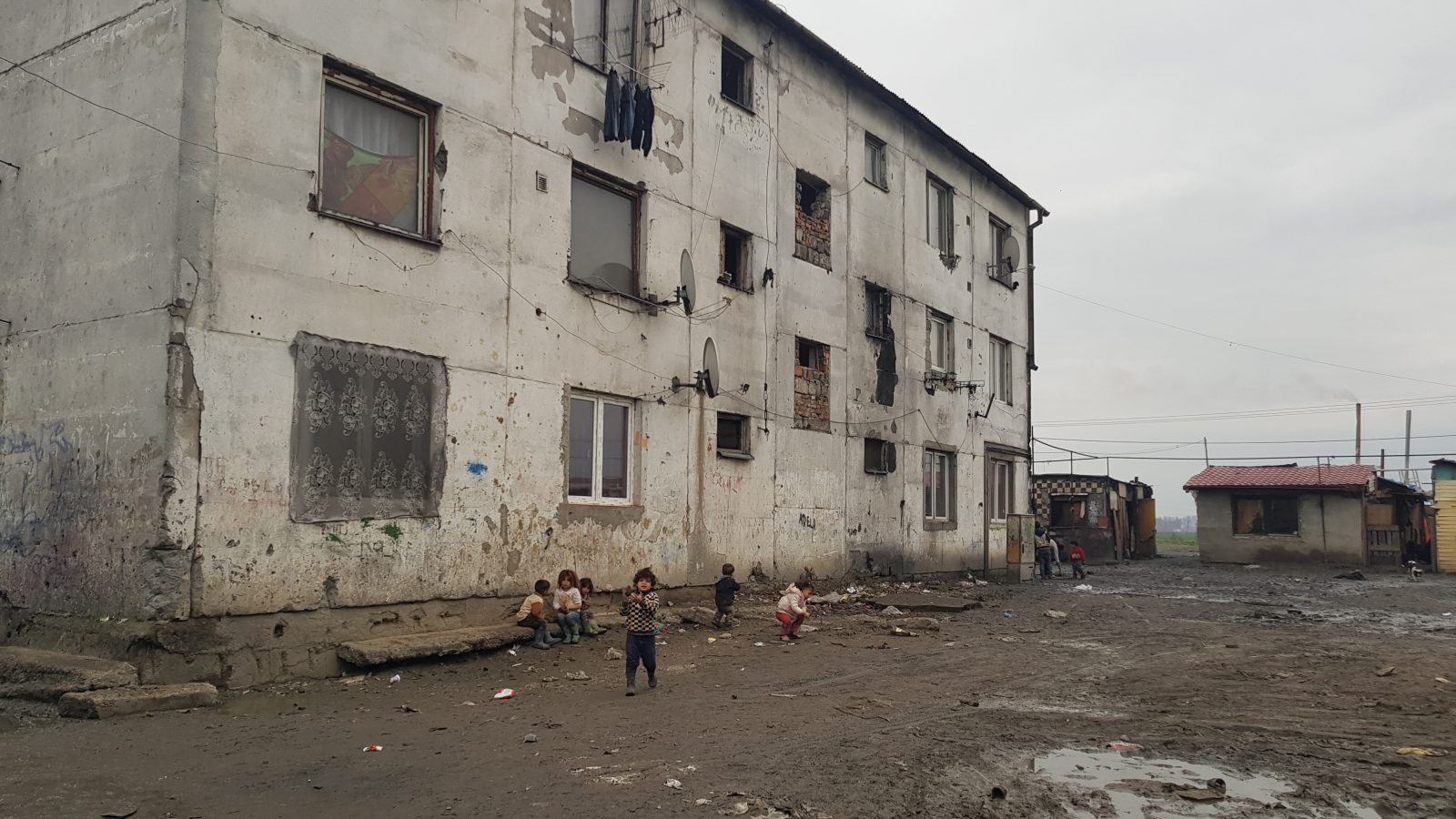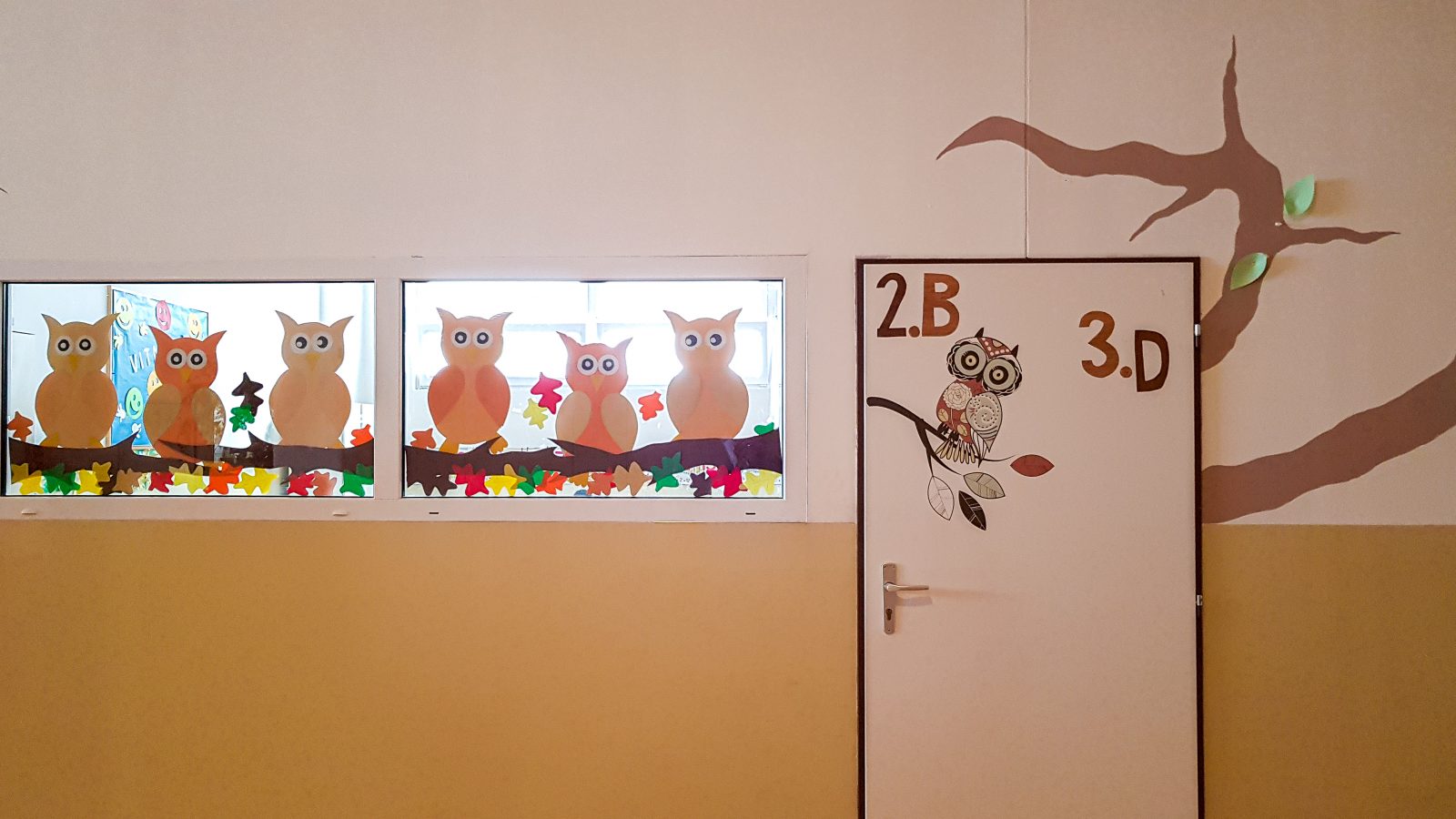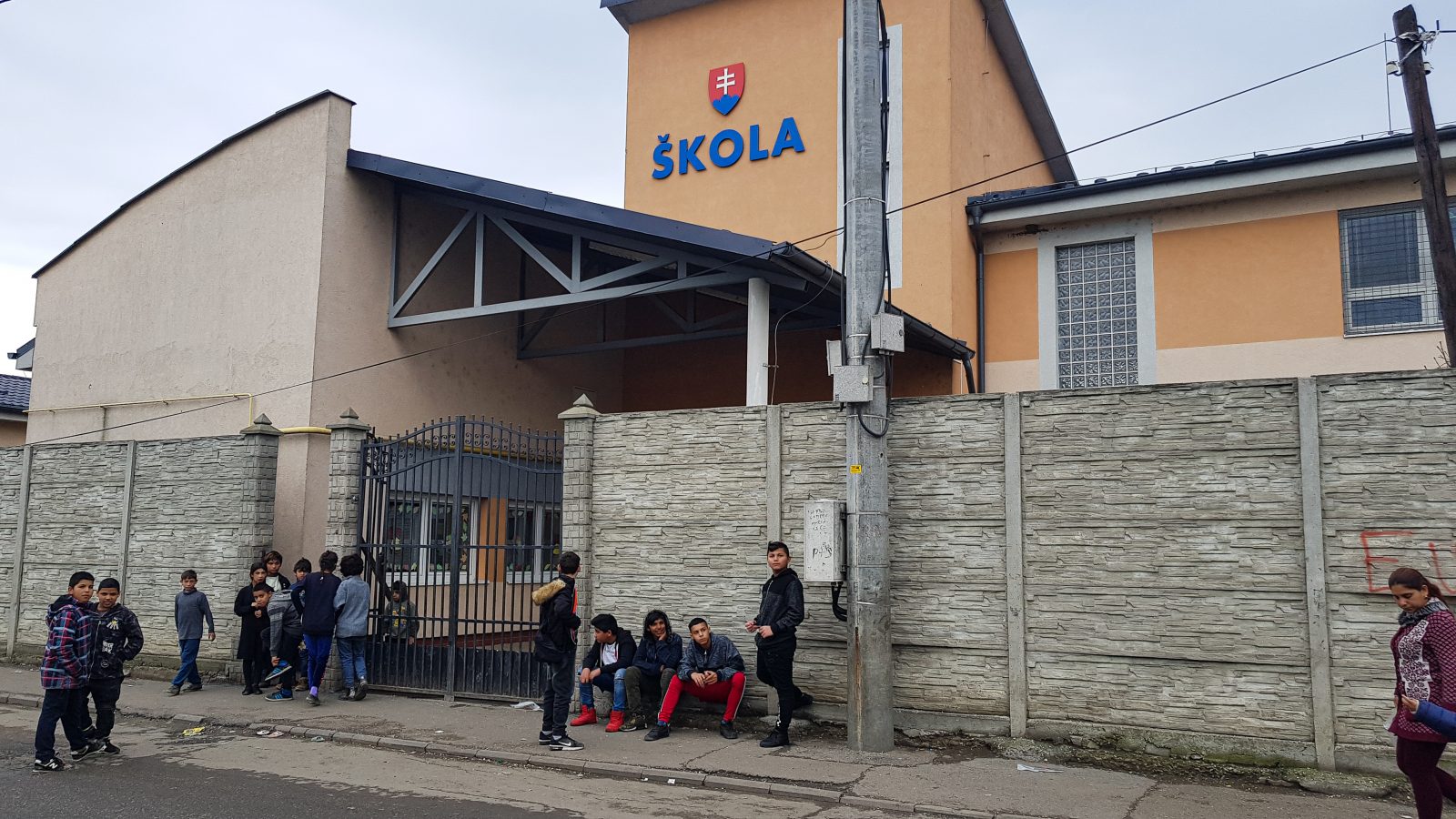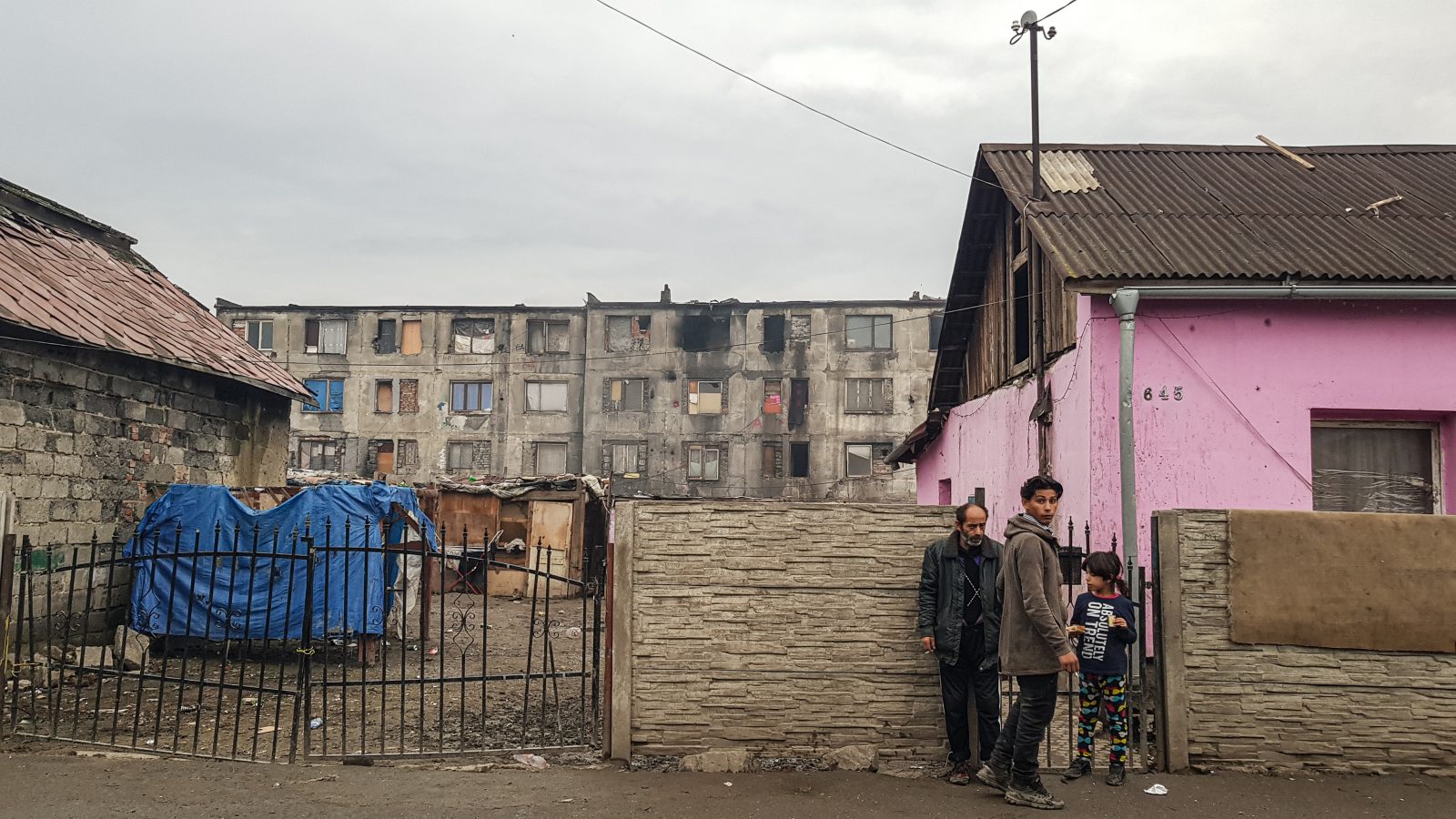15 April 2020
Originally published
27 November 2019
Source
Despite anti-discrimination laws, many Roma school children in Slovakia find themselves separated from their non-Roma peers, perpetuating a cycle of marginalisation.
Standing in a potholed road in a Roma settlement in the eastern Slovak town of Trebišov, Dezider Sandor, head of a Roma neighbourhood watch patrol, pointed to a group of children passing by.
“The future of these Roma people is education,” he said. But many of the children squelching through mud without shoes along the trash-strewn street will never attend school with non-Roma classmates or continue to higher education. According to a 2016 study by the EU’s Agency for Fundamental Rights, 62 per cent of Roma children in Slovakia are educated in segregated classrooms or schools — more than in any other European country.
In Trebišov, a town of 23,000 people, the Roma neighbourhood feels more like a ghetto than a settlement. More than 6,000 people live here, making it one of the largest Roma communities in the country. Conditions are generally dire. Most people live in ramshackle wooden shacks with tin roofs or in tenement blocks that seem on the verge of collapse. Few families have running water or sewer connections. Unemployment is through the roof.

Children play in the Roma settlement in Trebišov. Photo: © BIRN / Miroslava German Širotníková
National laws and international charters prohibit discrimination, and in 2012, a regional Slovak court explicitly banned separating students by ethnicity after a landmark case against a school in the northeastern village of Šarišské Michaľany. The school was ordered to start integrating the children immediately. At the time, it looked like it might become a model case for other problem schools in the country. Seven years later, education experts say Roma children still face discrimination, and a new segregated school is under construction in another village next to Šarišské Michaľany.
Meanwhile, the European Commission has threatened legal action against Slovakia over infringement of EU norms if the situation is not resolved soon. “It’s a huge problem, especially in eastern and central Slovakia,” Vlado Rafael, director of the Bratislava-based EduRoma rights organisation, told BIRN. “Segregation doesn’t only vilify children and offer a lower quality of education, but it destroys the human relationships in these regions for a long time. School should be a place where these relationships are cultivated.”
“Segregation doesn’t only vilify children and offer a lower quality of education, but it destroys the human relationships in these regions for a long time. School should be a place where these relationships are cultivated.”
Elena Kriglerová, a sociologist at the Centre for the Research of Ethnicity and Culture in Bratislava, said the problem had actually grown worse over the years. “It has extremely deep roots and now it’s being legitimised,” she said, adding that schools, teachers and parents often do not understand the principles of discrimination anymore.
Rights groups say Roma children are often automatically signed up for special education schools. And if they do end up in regular elementary schools, they are often segregated from their non-Roma peers. Sometimes the segregation happens organically, when a school is purposely built in a Roma-only district. Other times, non-Roma parents pressure schools to separate Roma children, or they take their children to bigger schools in town.
Although Slovak schools and institutions are not allowed to collect ethnic data, numerous organisations including the European Commission have in recent years studied how segregation happens and what it means for society. The Slovak education ministry and parliament have been working on several measures to encourage desegregation, but experts agree they have a long way to go. “The worst part is the normalisation,” sociologist Kriglerová said. “This deep conviction that this is basically right.”

The exterior of a classroom in a Roma-only school in Trebišov. Photo: © BIRN / Miroslava German Širotníková
‘Off the chart’
On the edge of the Trebišov Roma settlement, people of all ages mill around outside the local school. With cheerful, orange paintwork and autumn-inspired decorations in the windows, it looks like any other elementary school — aside from its towering walls and the fact that the students are all Roma children from the impoverished settlement. With no gymnasium or playground, staff at the school do their best to teach 980 children aged six to 15 in three buildings.
REPORTING DEMOCRACY
Investigating the state of democracy in the heart of Europe
Reporting Democracy is a cross-border journalistic platform dedicated to exploring where democracy is headed across large parts of Europe. It wants to unleash the power of independent journalism to scrutinise the issues, trends and events shaping the future of democracy in Central, Eastern and Southeast Europe.
Reporting Democracy is run by the Balkan Investigative Reporting Network, a non-profit network promoting free speech, human rights and democratic values in Southern and Eastern Europe and beyond. The programme is supported by ERSTE Foundation. This article was enabled through Reporting Democracy.
Marek Demeter, a social education specialist at the school, grew up in the settlement. He attended the school himself for four years before transferring to another school in town.
He went on to become the only member of the community to finish university, getting a doctorate in social work. “Our parents never went to segregated classes,” he said. “They were all integrated. And it wasn’t a problem back then. This separation is really bad for building relationships.”
Martin Farbar, deputy director of the school, showed BIRN the newest school building, taking a circuitous route around the settlement since rain had flooded the streets.
The building is within the confines of a high concrete wall that separates the Roma community from non-Roma homes and businesses outside. A gate connects the two worlds, but locals say it is often closed from the outside in the afternoon.
“It’s not normal stuff,” Farbar said. “We just got so used to it that it seems like that by now.” Sitting in his office, with Slovak and EU flags behind him and surrounded by hundreds of books to be given to the children, Farbar said communities were becoming more divided than ever.
“Here in the east, whole schools are changing,“ he said. “Village schools are becoming Roma only, and the town schools are for the majority.”
Farbar is Roma himself but he said he had always lived in an integrated community in a village about 20 kilometres from Trebišov. “I went to schools where we were all together,” he said. “We sat at the same desks, grew up together.” He added that the price of segregation was alienation and discrimination. “Where else can they [young people of different ethnicities] meet but at school?“ he said. “If they don’t, they meet as 18-year-olds, marked by various opinions, prejudices and stereotypes, and there are problems.”
“Here in the east, whole schools are changing. Village schools are becoming Roma only, and the town schools are for the majority.”
In a first grade class, Farbar helped a girl with curly hair sitting at a desk in the back find a letter S on her worksheet and colour a sun yellow. Like many of her classmates, she had no shoes and wore only socks on her feet. She had a beat-up old pencil case by her side.
Farbar said the school faced challenges unlike those at “normal” schools in Slovakia — and it was sometimes hard to explain these challenges to authorities in the capital, Bratislava. “The school system in Slovakia is based on charts,” he said. “And we don’t fit into any chart.”

The elementary school for children from the Trebišov Roma community. Photo: © BIRN / Miroslava German Širotníková
Although populist politicians frequently play up “Roma issues”, analysts say disparities in education have nothing to do with ethnicity and everything to do with poverty. National testing of fifth graders in January showed that children from socially disadvantaged backgrounds did comparably worse in all areas. While students in Bratislava averaged scores of 78 per cent in math tests, children from poor families averaged 23 per cent.
A report published in January by the finance ministry’s Value for Money Committee concluded that poverty is the main driver of exam failure, truancy and lack of progress to higher education, all of which limit job opportunities.
Experts say that even when education policies look good on paper, they are not always implemented on the ground. And while many blame the education ministry, the ministry says schools and the towns that run them should be more responsible for tackling segregation. “A huge number of people must take part in solving this,” Farbar said. “But not in 10 years. Tomorrow!”

Many members of the marginalised Roma community live in dire conditions in a settlement in Trebišov, Slovakia. Photo: © BIRN / Miroslava German Širotníková
‘Absolute bottom’
Farbar’s school in Trebišov ranks poorly in official test results, which he said reflected conditions in the settlement. “They are starting at the absolute bottom,” he said. “They are at the place where the rest of Slovaks might have been 100 years ago.” He added: “You can’t integrate these children into other schools in town. Not unless the settlement changes.”
Experts say desegregation also needs to start with teachers, who are often part of the problem. “The teachers’ approach is very similar to what communists did: everybody deserves the same, nobody gets anything extra,” said EduRoma director Rafael. “And to this day, there is no one who would explain to them that the equal approach doesn’t mean the same one.”
He argued that Roma children from poor families need special attention in the first years of school so they can get to the same level as other students. A lot of the children speak little or no Slovak when they come to school since they have spoken only Romani at home. And many come from home environments that offer little support for learning.
Although schools get bigger grants for students from socially disadvantaged communities, experts say many teachers are not equipped to deal with high numbers of children with special educational needs in class. “Teachers are not prepared to work in a diverse environment at all,” said sociologist Kriglerová. “They are taught to see the class as a homogeneous mass and only divide pupils into good and bad.”
“Teachers are not prepared to work in a diverse environment. They are taught to see the class as a homogeneous mass and only divide pupils into good and bad.”
Roma expert Rafael said the system is incapable of catering to children of various levels. “We have a tendency to support the talented Roma children, but to be blunt, who will support the less talented ones?” he asked.
Such issues mean that many young Roma children end up in special schools rather than regular elementary schools. The high number of Roma students in special education is one of the reasons why the European Commission is threatening to take Slovakia to the European Court of Human Rights. Neighbouring Czech Republic lost a similar case in 2007, and initiated education reforms as a result.
Rafael said that sending Slovakia to the European court could improve things. “Because then people would have to listen and make some changes,” he said. “If we’re not indicted, we’re going to lose all our means necessary to make the system change.” While many education specialists are sceptical that the courts can force change, most agree on the need for reform. “If there is no new plan, I give it 10 years before education here is segregated completely,” Farbar said.
First published on 27 November 2019 on Reportingdemocracy.org a journalistic platform run by the Balkan Investigative Reporting Network.
This text is protected by copyright: © Miroslava German Širotníková / Reporting Democracy. If you are interested in republication, please contact the editorial team.
Copyright information on pictures, graphics and videos are noted directly at the illustrations. Cover picture: First graders in a Roma-only school in Trebišov, Slovakia. Photo: © BIRN / Miroslava German Širotníková